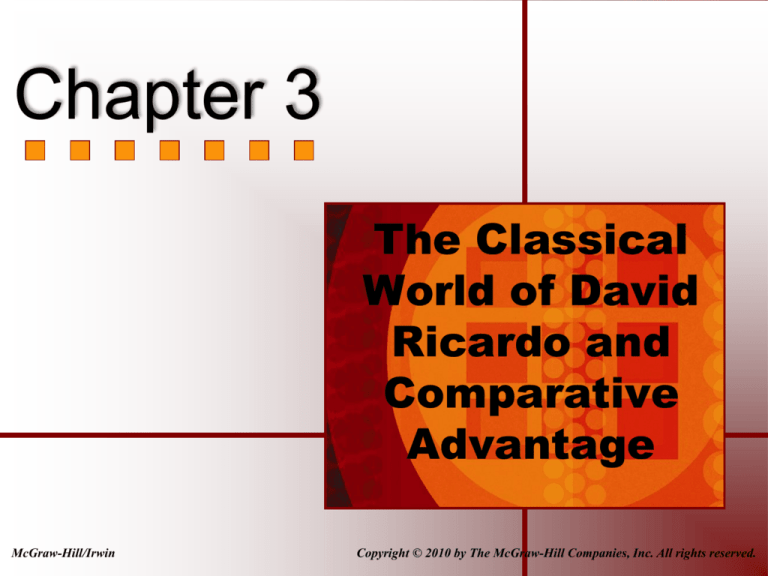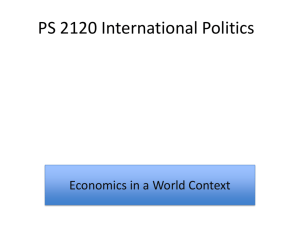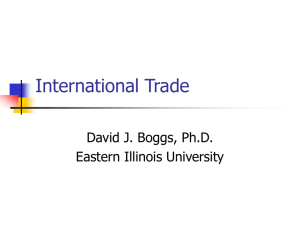
Chapter 3
The Classical
World of David
Ricardo and
Comparative
Advantage
McGraw-Hill/Irwin
Copyright © 2010 by The McGraw-Hill Companies, Inc. All rights reserved.
Learning Objectives
Explain comparative advantage as
the basis of trade.
Identify the difference between
absolute and comparative
advantage.
Calculate gains from trade in a 2x2
model.
Illustrate comparative advantage
using production possibility
frontiers.
3-2
Assumptions of the
Ricardian Model
A 2-country, 2-commodity world
Perfect competition
No transportation costs
Factors mobile internally, immobile
internationally
Constant costs of production
Fixed technology for each country
All resources are fully employed
The “labor theory of value” holds
3-3
Notation
Let:
ax = labor time to produce 1 X in
country A
ay = labor time to produce 1 Y in
country A
bx = labor time to produce 1 X in
country B
by = labor time to produce 1 Y in
country B
3-4
Comparative Advantage
Defined
Country A has a comparative
advantage in good X if:
(Px/Py)A < (Px/Py)B OR if
ax/ay < bx/by OR if
ax/bx < ay/by
If country A has a comparative
advantage in good X, country B must
have a comparative advantage in
good Y.
3-5
Comparative Advantage:
An Example
Corn (X)
U.S. (A)
Blankets (Y)
1 hour/bu 5 hrs/bl
Mexico (B) 3 hrs/bu
6 hrs/bl
Autarky Price
Ratios (APRs)
1B = 5C,
1C = 1/5B
1B = 2C,
1C = 1/2B
3-6
Comparative Advantage
Since the U.S.’s APR for corn is
lower than Mexico’s (1/5 < 1/2), the
U.S. must have a comparative
advantage in corn.
Since Mexico’s APR for blankets is
lower than the U.S.’s (2 < 5),
Mexico must have a comparative
advantage in blankets.
3-7
Comparative Advantage
and the Total Gains from
Trade
Ricardo’s argument is that trade
will be mutually advantageous as
long as the two countries’ autarky
price ratios are different.
How do we know that this is true?
3-8
Comparative Advantage and the
Total Gains from Trade
Table
The Production
Possibilities
Frontier
Cloth
Wine
Price Ratio in
3
Autarky
(PPF) is the set of all combinations
Country A
1 hr / yd
3 hr / bottle
1W: 3C
Country B
2 hr / yd
4 hr / bottle
1W: 2C
3-9
Comparative Advantage and the
Total Gains from Trade
Lets assume that Country A has 9,000 labor hours available
and Country B has 16,000 labor hours available.
Then, using Table 3,Country A can produce a maximum of
9,000 yards of cloth (9,000 / 1 hr per yard) with no wine
production and it can produce a maximum of 3,000 bottles of
wine (9,000 / 3 hr per bottle) with no cloth production.
Similarly, Country B can produce a maximum of 8,000 yards
of cloth (16,000 / 2 hr per yard) with no wine and a maximum
of 4,000 bottles (16,000 / 4 hr per bottle) with no cloth
production.
If we assume that these two countries exchange at the terms
of trade 1 W:2.5 C.
We also assume that country A exchanges 2,500 yards of
cloth for 1,000 bottles of wine.
3-10
Comparative Advantage and the
Total Gains from Trade
What are the gains from trade for these two countries if any?
Country A
Before Trade
After Trade
Cloth Production
6,000 C
6,000 C
Cloth Consumption
6,000 C
6,000 – 2,500(exported
cloth) = 3,500 C
Wine Production
1,000 W
1,000 W
Wine Consumption
1,000 W
(1,000 before trade+
1,000 imported wine) =
2,000 W
REQUIRED LABOR
HOURS OF
PRODUCTION
[ (6,000 *1 ) +
(1,000 * 3) ] =
9,000
[ (3,500 * 1) + (2,000*3) ]
= 9,500
3-11
Comparative Advantage and the
Total Gains from Trade
What are the gains from trade for these two countries if any?
Country B
Before Trade
After Trade
Cloth Production
3,000 C
3,000 C
Cloth Consumption
3,000 C
3,000 +
2,500(imported cloth)
= 5,500 C
Wine Production
2,500 W
2,500 W
Wine Consumption
2,500 W
(2,500 before trade 1,000 exported wine)
= 1,500 W
REQUIRED LABOR
HOURS OF
PRODUCTION
[ (3,000 *2 ) +
(2,500 * 4) ] =
16,000
[ (5,500 * 2) + (1,500*
4) ] = 17,000
3-12
Comparative Advantage and the
Total Gains from Trade
What are the gains from trade for these two
countries if any?
Gains from Trade (in terms of labor hours)
Country A:
After trade, residents of country A could consume
3,500 C and 2,000 W which would require 9,500
hours of labor so gains from trade is 500 hours
(9,500-9,000)
Country B:
After trade, consumption of residents by country B
would require 17,000 hours of labor so gains from
trade is 1,000 hours (17,000-16,000)
3-13
Comparative Advantage
and the Total Gains from
Trade
The Production Possibilities
Frontier (PPF) is the set of all
combinations of goods that a
country is capable of producing,
given available technology and
resources.
Suppose in our example the U.S.
has 1000 hours of labor available
and Mexico has 1800.
3-14
Comparative Advantage:
An Example
Corn (X)
U.S. (A)
Blankets (Y)
1 hour/bu 5 hrs/bl
Mexico (B) 3 hrs/bu
6 hrs/bl
Autarky Price
Ratios (APRs)
1B = 5C,
1C = 1/5B
1B = 2C,
1C = 1/2B
3-15
U.S. Production
Possibilities
Corn
1000
Slope: rise/run = -1000/200 = -5
A
500
100
200
Blankets
3-16
Slope of the PPF
for this example, -5
Notice: the slope (in absolute
value) is the APR of the good on the
horizontal axis.
Therefore, the slope is the
opportunity cost of the good on the
horizontal axis.
The slope is also the marginal rate
of transformation.
3-17
Mexico’s Production
Possibilities
Corn
600
Slope = -2,
or the opportunity cost of blankets
300
B
150
300
Blankets
3-18
Classical Model: The
Gains from Trade
Suppose that in autarky, the U.S. is
at point A, producing and
consuming 500 corn and 100
blankets.
Suppose that in autarky, Mexico is
at point B, producing and
consuming 300 corn and 150
blankets.
3-19
U.S. Production
Possibilities
Corn
1000
A
500
100
200
Blankets
3-20
Mexico’s Production
Possibilities
Corn
600
B
300
150
300
Blankets
3-21
Classical Model: The
Gains from Trade
Suppose now that the U.S. and
Mexico agree to trade at an
“exchange rate” of 1B = 3.33C (or,
1C = .3B).
If the U.S. specializes in corn, how
many units of corn could it produce?
1000.
If Mexico specializes in blanket
manufacture, how many blankets
could be made? 300.
3-22
The Gains from Trade:
U.S.
If the U.S. wants to continue to
consume 500C, they will now have
500C to trade for blankets.
If the “exchange rate” is 1B = 3.33C
(or, 1C = .3B), how many blankets can
the U.S. get in exchange for 500C?
150
Therefore, the U.S. can consume
outside its PPF (to point C) by
trading!
3-23
U.S. Production
Possibilities
Corn
1000
A
C
500
100 150 200
Blankets
3-24
The Gains from Trade:
Mexico
If Mexico wants to continue to
consume 150B, they will now have
150B to trade for corn.
If the “exchange rate” is 1B = 3.33C
(or, 1C = .3B), how much corn can
Mexico get in exchange for 150B?
500
Therefore, Mexico can also move
outside its PPF (to point D) by
trading!
3-25
Mexico’s Production
Possibilities
Corn
600
500
D
B
300
150
300
Blankets
3-26
The Gains from Trade
Note: In general, the Ricardian
model results in complete
specialization.
However, in trade between a small
and a large country the small
country may not be able to produce
enough to satisfy the large country;
the large country might then
partially specialize.
3-27
The Consumption
Possibilities Frontier
(CPF)
The CPF is a collection of points that
represent combinations of corn and
blankets that a country can consume
if it trades.
3-28
U.S. Consumption
Possibilities
Corn
1000
A
C
500
CPF
100 150 200
300
Blankets
3-29
The Consumption
Possibilities Frontier
(CPF)
The CPF’s slope is the same as the
terms of trade.
The CPF pivots around the
production point.
If trade is to the benefit of a country,
the CPF lies outside the PPF.
3-30
Mexico’s Consumption
Possibilities
1000
CPF
Corn
600
D
500
300
B
150
300
Blankets
3-31
The Limits to Mutually
Advantageous Trade
“Exchange rate” must be at least
as great as Mexico’s APR.
“Exchange rate” must be no greater
than the U.S.’s APR.
Bottom line: we still don’t know
how the terms of trade will be
determined, but they must be
between the countries’ APRs if
trade is to be mutually beneficial.
3-32
The CPF and “Small”
Countries
The nearer are the terms of trade to
a country’s APR, the less that
country will gain from trade.
The farther away the terms of trade
are from a country’s APR, the more
that country will gain from trade.
Moral: to Ricardo, small countries
stand to gain a lot from trade, large
countries gain less.
3-33






